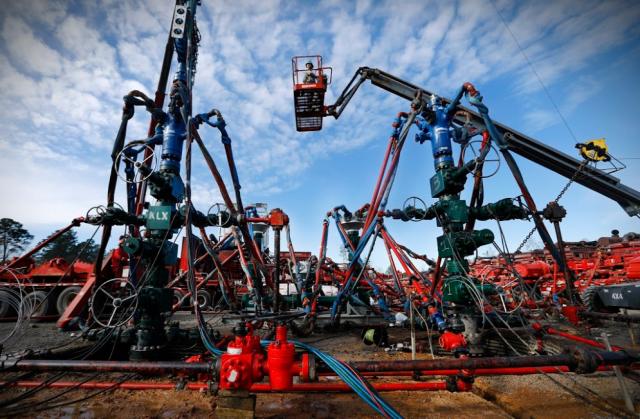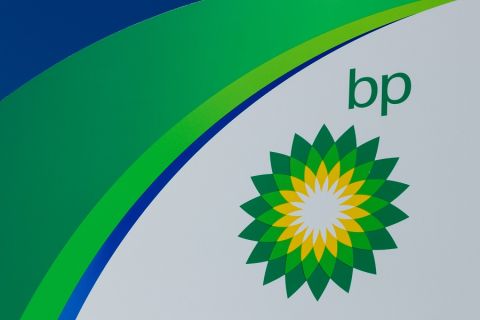
Frac crew in the Haynesville Shale in December 2017. (Source: Hart Energy)
[Editor's note: A version of this story appears in the February 2020 edition of Oil and Gas Investor. Subscribe to the magazine here.]
Looking back, 2019 was a stare down between investors and operators, with investors demanding the latter to hold the line on generating free cash flow. E&Ps, likewise, faced overcoming long-held habits of growing through the drillbit as fast as possible while smelling the sweet aroma of rising commodity prices throughout the year. Oh, to add a rig and a bit of boe per day!
Yet upstream operators might be passing the blink test, by and large.
There was a day when the industry measured success by growth rate and production volumes. Today, less is more on those metrics, at least in the minds of the capital providers. Now, more return of capital to said investors is less punishable in the markets.
In advance of fourth-quarter reports, several analysts have surveyed the field and found E&Ps to be breathing calmly as 2020 capex figures begin to be revealed.
“Continuation of capital discipline is another key factor that is a prerequisite for investors to become more sanguine on energy, and we think this continues into ’20 regardless of oil prices,” said U.S. Capital Advisors (USCA) analyst Cameron Horwitz in a Jan. 9 report.
The USCA analysts surveyed fourth-quarter permitting and, while the Permian Basin and Eagle Ford Shale showed modest ramps, all other basins trended down, some sharply. “Bottom line, forward indicators are not suggesting E&Ps are aggressively planning to ramp back up this year, which is a positive for sentiment, in our view.”
Better, at current strip, its models show an average return on capital employed increasing by 300 basis points to 8% in 2020 and half of its covered companies free cash flowing by 5%.
Reporting from its recent investor conference, Cowen energy analysts said E&Ps echoed consistent messages of focusing on free cash flow. “Budgets appear relatively set given the current $55/bbl-plus 2020 WTI curve, and we would not anticipate any incremental rig additions beyond what has already been communicated.
“In general, management teams are ‘holding the line,’ focused on high-graded zones, marginal capital efficiency gains and looking to raise investor confidence in free cash flow generation.”
Oilfield prognosticator RBN Energy projects a 13% decline in capex this year, representing some $9 billion less capital deployed in the E&P space, with a total outlay of $61 billion. That follows a downdraft of 11% in 2019.
But what about old habits? Natural gas players might be feeling the pinch of $2/MMcf, but oil prices are flirting with $60 and briefly topping that with a little geopolitical buzz.
“With the recent rally in crude prices and capital budgets resetting, the question is whether producer capital discipline will hold in 2020? We think it will,” noted Barclays in a Jan. 9 report. “We think large-cap E&Ps have made their choice and broadly will continue down the path of capital discipline.” Several have already “downshifted” year-over-year 2020 production growth outlooks in favor of free cash flow, it said. “We think executives ‘get it.’”
In its 2020 E&P Spending Survey released in December, Barclays estimates U.S. onshore spending to decline by 10% over 2019 figures.
But it’s 2018 and 2019 figures that illustrate the large-cap E&P community’s “seismic shift” commitment to capital discipline, the analysts suggest. In 2018, the “plowback” ratio—drill-and-complete capex as a percent of discretionary cash flow—was 83%. 2019 marked a 10-year low at 80%. Compare that to 142% plowback in 2015. “Capex levels have been brought down to almost maintenance levels.”
2020 could go even lower. “We expect the plowback ratio to be significantly lower than 2019 levels at 67% as the purse strings remain tight.”
Small- to mid-cap E&Ps will follow a similar path, predicts Barclays. It expects SMID-cap upstream spending to decline by another 8% this year, following a 19% drop last year. This from a group that fundamentally needs to grow.
The majors and international oil companies are the iconoclasts. Barclays expects this group to increase North America spending by 6%, following a 14% uptick in 2019, offsetting other declines. “The majors are following through with aggressive unconventional growth plans and are showing they are largely oil price insensitive.”
But the path forward is set, according to RBN analyst Nick Cacchione in a blog.
“There has always been an aura of excitement, adventure and risk surrounding the quest to unlock natural resources, from the California Gold Rush to the early days of Texas oil wildcatting,” Cacchione said. “Today’s exploration and production leaders may be just as passionate as their predecessors, but the riverboat
gambler-type days of reckless spending in pursuit of growth now seem like a distant memory.”
The gamble is whether investors will finally ante up if independents take capex chips off the table. 2020 could tell the tale.
Recommended Reading
Magnolia Appoints David Khani to Board
2024-02-08 - David Khani’s appointment to Magnolia Oil & Gas’ board as an independent director brings the board’s size to eight members.
BP Pursues ‘25-by-‘25’ Target to Amp Up LNG Production
2024-02-15 - BP wants to boost its LNG portfolio to 25 mtpa by 2025 under a plan dubbed “25-by-25,” upping its portfolio by 9% compared to 2023, CEO Murray Auchincloss said during the company’s webcast with analysts.
The OGInterview: Petrie Partners a Big Deal Among Investment Banks
2024-02-01 - In this OGInterview, Hart Energy's Chris Mathews sat down with Petrie Partners—perhaps not the biggest or flashiest investment bank around, but after over two decades, the firm has been around the block more than most.
Petrie Partners: A Small Wonder
2024-02-01 - Petrie Partners may not be the biggest or flashiest investment bank on the block, but after over two decades, its executives have been around the block more than most.
BP’s Kate Thomson Promoted to CFO, Joins Board
2024-02-05 - Before becoming BP’s interim CFO in September 2023, Kate Thomson served as senior vice president of finance for production and operations.





